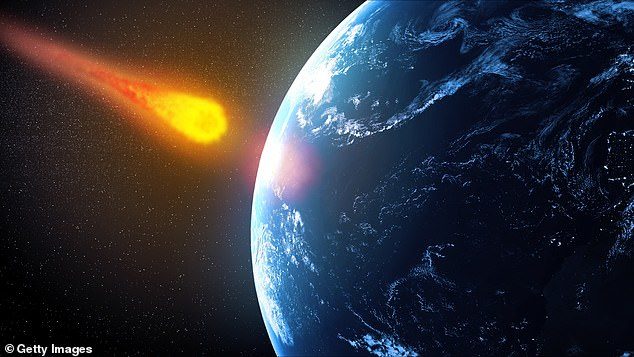The asteroid, dubbed 2013 MD8, is expected to skim past Earth at just over 3 million miles away, or about 13 times the distance between Earth and the moon, at 12:55pm (ET) on Tuesday.
The huge space rock is expected to make a 'close approach' to Earth, but its trajectory should see it soar safely by.
The asteroid, dubbed 2013 MD8, is expected to skim past Earth at just over 3 million miles away, or about 13 times the distance between Earth and the moon, at 12:55pm (ET) on Tuesday
NASA considers an asteroid to be 'hazardous' if they come within 4,600,000 miles of our planet.
Asteroid MD8 falls under the category of a 'near-earth object' (NEO), which NASA describes as all asteroids and comets that orbit within 30 million miles of Earth.
NASA tracks this and other near-Earth objects (NEOs) to keep track of any potential incoming threats.
However, there is little to be worried about, even with MD8 being a near-earth-object.
'No human in the past 1000 years is known to have been killed by a meteorite or by the effects of one impacting,' scientists at NASA's Jet Propulsion Laboratory explained.
Comment: See here for a list of the many deaths and disasters caused by incoming space rocks in recent history: Meteorites, Asteroids, and Comets: Damages, Disasters, Injuries, Deaths, and Very Close Calls . And lest we forget that as recently as 2013 a fireball that exploded over Chelyabinsk, Russia, injuring thousands of people and causing widespread structural damage: Fireball explodes over Russian city
'NASA knows of no asteroid or comet currently on a collision course with Earth, so the probability of a major collision is quite small.
'In fact, as best as we can tell, no large object is likely to strike the Earth any time in the next several hundred years,' they continued.
The agency believes that out of the more than 600,000 known asteroids in our solar system, roughly 16,000 are NEOs.
MD8 also falls under the category of a 'potentially hazardous object,' which are those that reach a minimum distance less than .05 au from Earth and have an absolute magnitude (H) of 22.0 or brighter.
Asteroid 2013 MD8 has an absolute magnitude of 24.2.
WHAT COULD WE DO TO STOP AN ASTEROID COLLIDING WITH EARTH?
Comment: As it is, very little.
Currently Nasa would not be able to deflect an asteroid if it were heading for Earth but it could mitigate the impact and take measures that would protect lives and property.
This would include evacuating the impact area and moving key infrastructure.
Finding out about the orbit trajectory, size, shape, mass, composition and rotational dynamics would help experts determine the severity of a potential impact.
However, the key to mitigating damage is to find any potential threat as early as possible.
Nasa is currently moving forward with a refrigerator-sized spacecraft capable of preventing asteroids from colliding with Earth. A test with a small, nonthreatening asteroid is planned for 2024.
This is the first-ever mission to demonstrate an asteroid deflection technique for planetary defence.
The Double Asteroid Redirection Test (DART) would use what is known as a kinetic impactor technique-striking the asteroid to shift its orbit.
The impact would change the speed of a threatening asteroid by a small fraction of its total velocity, but by doing so well before the predicted impact, this small nudge will add up over time to a big shift of the asteroid's path away from Earth.




Comment: NASA has documented a sharp uptick in NEOs which potentially pose a threat to civilization, but more concerning are these that we have yet to detect. As noted in the article Earth enters densest stream of deadly Taurid meteor cluster this June: And if an asteroid the size of that in Tunguska struck over a major city it would cause mass mortality.
See also:
- NASA animation shows the dramatic increase in near-Earth asteroids entering solar system over last 20 years
- In the blink of an eye: Astronomers seek backup to capture strange stellar blackout with help of cell phone cameras
- Of Flash Frozen Mammoths and Cosmic Catastrophes
- Meteor fireball sighted in 5 countries in Europe, photographed by 3 sky cameras
And to hear what the historical records have to say on the matter, check out SOTT radio's: Behind the Headlines: Who was Jesus? Examining the evidence that Christ may in fact have been Caesar!